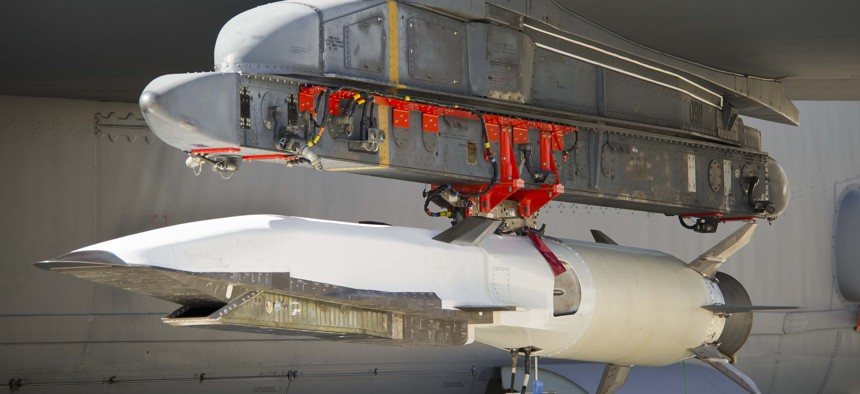
The X-51A prototype hypersonic missile The US AIR FORCE
Lockheed Martin Hopes the US Has Turned the Corner on Hypersonics
March test ‘one of the biggest steps we've seen’ in development of new hypersonic weapons, company officials say.
That the United States is behind China and Russia in the area of hypersonic weapons is no secret. But the successful endurance test of a new jet-launched hypersonic in March is giving weapons maker Lockheed Martin hope that the United States is on track to close the gap.
Defense One last week sat down with representatives from Lockheed Martin at the company’s Skunk Works site in Palmdale, California, shortly after the Defense Department announced the successful test of a jet-launched cruise missile—the Hypersonic Air-breathing Weapon Concept, or HAWC—in March. Lockheed Martin is one of the contractors on that program, and the test coincided with the Russian use of a hypersonic missile against a Ukrainian military target in March.
Atherton Carty, vice president of strategy and customer requirements at Lockheed Martin Skunk Works, said the successful HAWC test and other recent advances in hypersonics development suggest faster progress from here on. Hypersonic weapons development is a lot more challenging from a science perspective than almost anything else the Defense Department is spending money on, he said. Making a rocket that can travel at five times the speed of sound but with the advanced guidance and propulsion maneuver at extremely high speeds isn’t easy. But once those big scientific problems are solved, smaller ones become a lot easier.
“There are a few sets of hard problems around hypersonics, around: What do you do with all the heat? How do you control yourself at very high speeds… control communications through plasma layers? All of those physics things that you can read about, to some extent, those are common across various regimes in hypersonics. Everything that we learn and apply can be reapplied and adapted in other spaces,” he said.
“The progress we've seen here, just in this recent chapter, is one of the biggest steps we've seen in making true on that dream of a practical realization of hypersonics.”
For some, those recent hypersonic successes are bittersweet. The United States had been the leader in the development of hypersonic weapons for years. Australia flew the first scramjet engine back in 2002, but NASA flew one just two years later. Then the Air Force launched a program with Boeing in 2010 called X-51 A, to develop a hypersonic scamjet engine to fit in a missile that could be fired from a bomber. Mark Lewis, who currently heads the Emerging Technologies Institute at the National Defense Industrial Association, told Defense One that the X-51 A is a great example of short-sighted policy making getting in the way of technology development. The prototype didn’t quite reach the speed of sound, but the Air Force saw that the design was able to fly for as long as it had fuel.
“And then what do we do? The logical thing would have been to continue to expand the flight envelope, do more flights, expand Mach number [closer to the speed of sound], do studies of… stability, control, maneuvering all that stuff. Instead, we ended the program.”
The Air Force handed the research portfolio on hypersonics over to DARPA, which typically does not take over programs from other services, but rather tries to break ground in new areas. DARPA essentially went back to the drawing board, Lewis said. “The result is that the next scramjet flights that we had in the United States were part of the DARPA HAWC program…So that was an 11-year gap in employing supersonic combustion jamjets. So it's not surprising that we get sent back when we do things like that.”
Deputy Defense Secretary Kathleen Hicks on Wednesday echoed that sentiment; she visited Skunk Works last week as part of a trip to California.
Hicks called hypersonics a good example of a trend where, “The United States… used to be first-in-class at the innovation approach inside government: test, be willing to fail, learn a little, test again, learn.” But the United States government has developed an unhealthy risk aversion, and the delay in hypersonic research is symptomatic of that, she said.
“What we see in general is a real resistance to that approach and concern over… whether the US investments are making a difference up on Capitol Hill. And so you get curtailment of programs. You get concerns over concurrency,” she said, referring to multiple research programs in one area.
The United States is currently pursuing several different hypersonic programs. While HAWC has achieved some important milestones, the Defense Department cut funding for the AGM-183A Air-Launched Rapid Response Weapon, or ARRW, program in its most-recent budget request. But the budget also makes big asks for emerging technology, some $130 billion for new technology, which includes $800 million for new testing facilities—directly applicable to hypersonics where a lack of suitable test ranges has hampered progress. The United States is also pursuing a new joint research effort between the United States, Australia, and the United Kingdom around hypersonic development, the three countries announced earlier this month.
“These are technologically risky approaches sometimes,” Hicks said. “We have to be willing to fail. I think this is a place where we want to increase our trust, the trust that Congress has in the department as it goes after improvements and its capabilities.”
